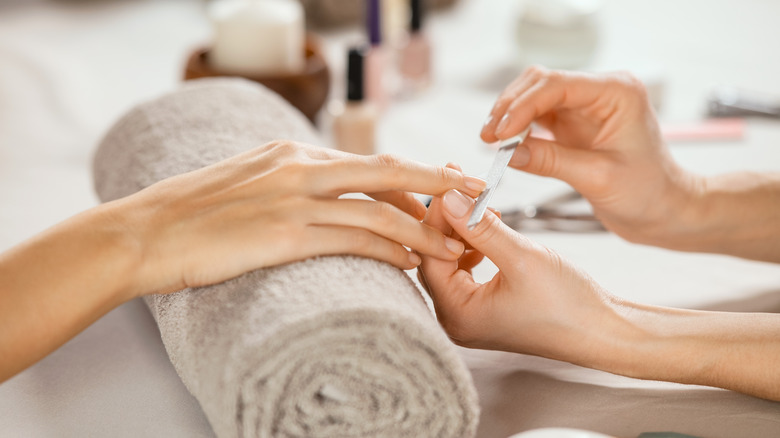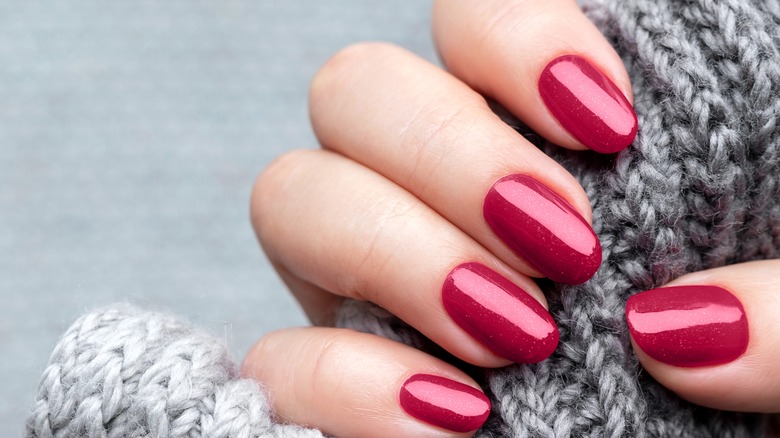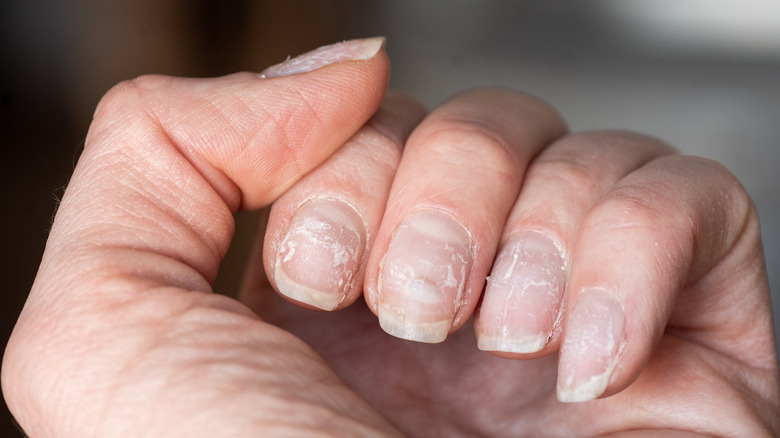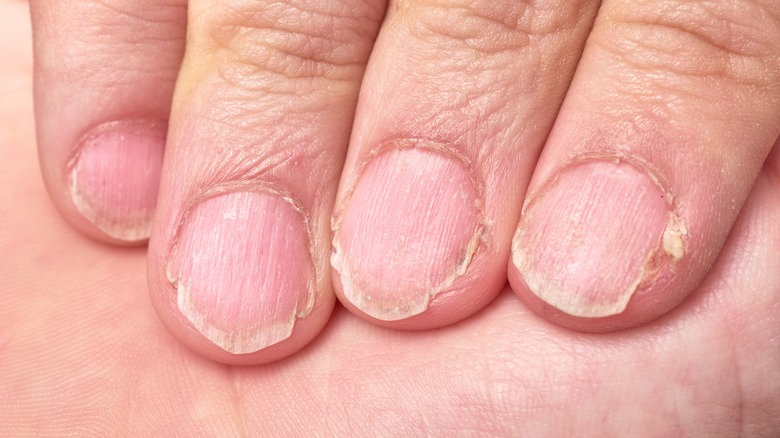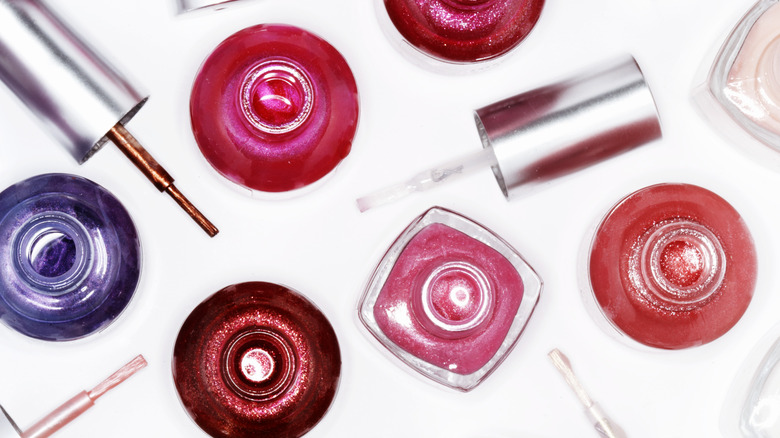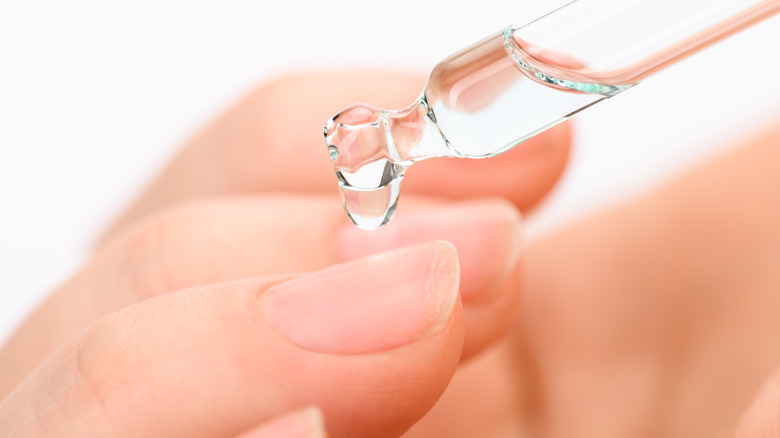Signs It's Time To Give Your Nails A Break From Polish
Nail polish formulas have been changing and evolving for thousands of years. Literally. The first-ever known use of what could be considered nail polish dates all the way back to Babylonia circa 3200 B.C., at which time, it is thought that the color of the nail lacquer used might have signified class. Black nails seem to have been relegated to higher classes, while people of lower classes painted their nails green (via Byrdie). In 3000 B.C., people in China used nail color as a sign of class rank and dynasty, and by the time Cleopatra was ruling Egypt, henna was being used as nail color. Cleopatra's color of choice? Red.
But flash forward to more modern times, and nail lacquer has been made with less natural ingredients than it once was. In 1925, Cutex created what we still would recognize as the first ever liquid nail polish, and later in the decade, makeup artist Michelle Menard was hard at work trying to create a shiny nail lacquer that resembled the eye-catching glossy paint used on cars. She succeeded, and by 1932 she had founded her now-famous brand that still sells countless colors and formulas of nail polish: Revlon.
Today, we have everything from gel polish to peel-and-stick polish strips, but one simple fact remains: no matter what formula you're using, it's likely your nails will at some point need a break from polish for their own health. Here are some signs it's time to take that breather.
Color that won't come off
Arguably, what keeps us using nail polish, no matter the formula, is the gorgeous array of color choices that allow us to express ourselves in countless different ways. But the intention is always for that color to be temporary. When we're ready to change colors, we generally wipe away last week's hue with a cotton pad and some acetone polish remover, but even so, some of that color can be left behind.
Most of us who regularly use liquid polish know that the cardinal rule is to always use a base coat before applying the color to both help the colored polish last longer and also to protect our nails themselves from staining. Unfortunately, even when we follow this rule, some polish colors and formulas are so intense, that staining happens anyway. This staining means that some of the ingredients of the polish have seeped into your nail itself. Since a great deal of those ingredients are chemical in nature, if you notice you have staining of your nails or any discoloration, it's a good time to take a break from polish for a few weeks.
Peeling
Peeling is another major sign that your nails need a break from polish (via Allure). Sometimes, when liquid polish chips or peels off, it takes a layer of your nail with it. Stick-on polish strips can do the same thing. But even if you are very careful when removing your polish and you don't chip or peel your nail itself while doing so, the wear and tear over time that constant polish-wearing can cause often results in your nails peeling on their own.
If after several manicures in a row, you notice that your nails are peeling or that the top layer of your nail seems to be lifting away from the rest, you should take a break from nail polish for a while. Letting your nails get enough air should help, and you could also consider using a cuticle oil or a strengthening, nourishing moisturizer on your naked nails until they seem healthier and happier again (via Byrdie).
It's also worth noting that nutritional deficiencies can also cause nails to peel, so if you don't regularly use polish but are still noticing peeling nails, make sure you are getting a full range of essential nutrients.
Weak, brittle nails
Weak, brittle nails are another sign that it might be time to take a break from polish for a while. All nail polishes, whether liquid, gel, or otherwise, contain ingredients that sap moisture from the nail bed. When polish stays on for long periods of time and then new polish is immediately applied, your nails don't get a chance to recover and restore their natural moisture balance (via Prevention).
As such, if you are a committed polish-wearer and have noticed, upon removing your most recent nail color, that your nails seem dry, brittle, and weak, this is a good time to give your nails some time to recover. Regular use of moisturizing lotions, cuticle oil, or nail strengthener could all help here. And again, this is a good time to make sure there is no other factor contributing to you weak nails by ensuring you're getting a full range of nutrients.
Another tip to prevent weak, brittle nails when using polish is to avoid over-buffing your nails before the application of polish. While roughing up the nail bed a little helps the polish to adhere better, repeatedly doing so can weaken the nail and leave it more vulnerable to drying agents and other damage.
Some polishes are safer than others
While it's important to take a break from polish now and again no matter which type of polish you use, it's also good to know which types of manicures are more damaging than others.
Where it comes to liquid polishes, some formulas are more friendly to the health of your nails than other formulas. "It is best to read the label before use," Dermatologist Dr. Sonia Batra told Today, "as different brands of nail polish contain a range of potentially toxic and irritating chemicals, including alcohol, various fragrances, toluene, formaldehyde and dibutyl phthalate."
Meanwhile, gel manicures that need to be soaked off and dip powder manicures are known to be even more damaging to your natural nails than liquid polish tends to be. Because of this, if these are the polish choices you prefer, it's smart to take more frequent and longer breaks between manicures to ensure the continued health of your nails and prevent some of the common damage we've covered above.
How to restore health to your nails
Once you've decided to take a little break from nail polish, there are some steps you can tale to help your nails get the most out of their time being naked and free. Allure recommends using a nail-moisturizing oil daily as well as a cuticle oil. It's important to resist picking at dry or brittle nails or cuticles, as this can cause further damage. Further, if you are a nail biter, these oils might help make your fingers a little less appetizing. After all, picking and biting not only causes damage, but can also be a doorway to infection if you are breaking the skin around your nails.
Make sure you are getting well-rounded nutrients and that things like vitamin E and healthy fats are included in your diet, as helping your skin and nails to heal from the inside is a very real thing.
Also, try to avoid harsh soaps and cleansers. If you are cleaning your kitchen or bathroom, make sure to wear protective gloves so that the detergents and sprays don't do any further damage to your nails and skin while they are healing and recovering.
